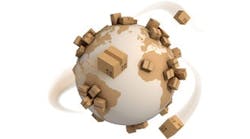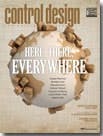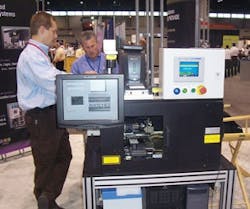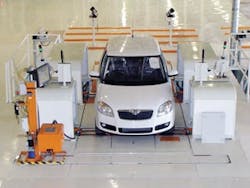Just as machine builders know their own strengths and the needs of long-time customers, they must become equally familiar with the requirements, business practices and standards of potential users in new countries. Very logical, but international markets and regions require a lot to be learned quickly — and sometimes builders must redesign equipment to meet these new demands.
Likewise, 20-year-old Invotec Engineering, an integrator and builder in Miamisburg, Ohio, grew up serving users in North America, but started offering its custom medical device assembly, test and inspection systems and related services internationally in 2005–06 (Figure 1).
Source: Fori Automation
"Our customers needed our equipment in their facilities outside the U.S., mostly in Mexico, some in Europe and a little in China," says David Barton, Invotec's business development manager. "A customer will tell us what they want, such as a manufacturing system for a newly developed surgical device, and we'll design and build it in-house. But then we'll bring in their engineers and line operators from Mexico, for example, and they'll train with us and validate their new system at our facility. After that's done, we ship the system to them. We also travel to their facilities to get new systems up to speed, and we make some service trips."Many Partnerships, Some FriendshipsWhat do you do if you can't just ship machines, but you also don't have the funds to open a sales and service office? There are a number of partnerships that you can set up to develop local contacts, complete sales, offer support, maintenance and repair, and even perform assembly and component manufacturing.Consider the approach of Edgewater Automation in St. Joseph, Mich., which designs and builds custom automation equipment for automotive, battery, solar, medical, test and measurement, and other applications. About a year after it started up 11 years ago, Edgewater formed a strategic alliance with Manders Group, which consists of eight financially independent, but technically complementary companies located in the U.S., the Netherlands, Germany, France, Romania and India, each designing and building custom integrated automation systems.
"If we build and send a machine to Europe, our members there will support us with standards compliance and maintenance," explains Seth Vander Ark, business development manager at Edgewater. "If one of them builds and sends a machine to the U.S., we'll help support them and their users here. Penta Automation in India joined us five or six years ago, and now we outsource to them, and they build components for us, such as tooling devices and fixtures. Sometimes we make components for them when materials are cheaper here. We're all still independent, but we've also become good friends over the years."
To help builders learn about and form their own partnerships, several trade associations offer practical assistance and meeting places where they can meet potential, international customers. For example, the Assn. for Manufacturing Technology (AMT) has established incubators with technology centers, showrooms and support services for builders and users in Shanghai, China; Chennai, India; and Monterrey, Mexico, says Jeff Travers, business development manager. "We say that builders have to be competitive at their customer's doorstep, and this program is one way they can compete and grow globally," he states.
Cross-Country Coordination
Naturally, as some partnerships deepen over time, their participants might evolve and merge to become unified corporations. However, despite their size and strength, they still face the same unremitting economic forces, organizational juggling and customer demands as the rookies do.
Fori Automation in Shelby Township, Mich., builds automation, assembly, welding and testing systems, automated guided vehicles (AGVs) for aircraft assembly, and related equipment. And, since it was established in the U.S. in 1984, it's added divisions in South Korea, Brazil, Germany, China, India, Mexico and Tennessee. It grew internationally by first working through representative organizations, later hiring its initial sales representatives as Fori employees, and eventually building design and manufacturing facilities in its new countries, explains Paul Meloche, Fori's vice president of sales.
Fori's innovations include what Meloche describes as its complex, automated, robotic, algorithm-enabled toe, caster and camber wheel aligners, which automotive production lines use for installing and adjusting tie rods and cam bolts on front- and rear-vehicle suspensions. Three years ago, Fori also diversified into aerospace, and developed automated, compact AGVs with up to 60,000 lb capacity for aircraft assembly. They use controllers, safety PLCs and wireless modules from Siemens Industry, and provide more continuous motion and smooth, faster throughput than the cranes that were formerly used.
[sidebar id="4"]"We do a lot of global projects, and often use four or five Fori companies to design and build a single system," Meloche says. "This gives us a lot of added flexibility to meet a customer's requirements, and lets us decide on the perfect formula for accomplishing it. For example, a few years ago, we delivered a large chassis marriage system, cockpit assembly system with robotic loading, and wheel-installation, alignment and headlamp aim system to Volkswagen's greenfield plant in Pune, India (Figure 2). The client wanted project management done in Wolfsburg, Germany; component and system design in the U.S., Germany or South Korea; equipment construction in China, South Korea and the U.S.; and local commissioning, startup and support in India. Consequently, we were able to split the VW purchase order (PO) between Fori Germany, Fori Automation U.S. and Fori India. So assembly carriers and smaller assemblies were built in China; robotic cockpit system and precision chassis marriage plates were built in South Korea; wheel alignment and headlamp system were built in the U.S.; and installation and startup was completed onsite by Fori India with support from Fori USA and Fori Korea."
All together, Fori's method of splitting the POs saved about 35% on import duties and taxes associated with Fori India's integration, installation and commissioning scope of work. "This was good for Volkswagen because they got the lowest price, the German product management and design they wanted, and the local commissioning and support they needed in Pune," he says. "Being able to split POs enables our established companies to build and ship smaller parts of large production lines — we call them knockdown kits — and then do final integration at the customer's local site."
To accomplish international projects like the Volkswagen plant, machine builders must investigate a customer's requirements and preferences, add up all costs of each strategy for performing a project, and evaluate its capacity to work globally, Meloche adds. "We can play by anyone's rules as long as we know what those rules are," he says. "Sometimes this also means educating the customer. But working internationally also requires legal and financial help on dealing with currency fluctuations, importation laws, and splitting POs. It's good to not be overly bureaucratic. We're a relatively small, privately held company, so we can work lean, be flexible, and win orders on quality, delivery and price, too."
Siemens' OEM Partner program also can give builders many of the same capabilities for serving customers worldwide, adds Paul Ruland, product marketing manager for Siemens' automation systems. "End users everywhere push builders to provide more flexibility, local support and quicker delivery," he says. "So we recently formalized our OEM Partner program to help builders provide more transparent, consistent information about their capabilities, specific projects and timelines through our Globebiz unified database, which can help keep all their locations in tune."
Simple Designs, Modular Components
Besides researching new markets, forming partnerships and even starting subsidiaries, simplifying designs and developing standard modular components can make it easier to transport, assemble, maintain and repair equipment in remote and unfamiliar areas.
"As end users become more global, they're requiring machine builders to ship equipment to different continents, and so builders learn it's no longer enough to provide their usual, off-the-shelf machines from stock," says Robert Muehlfellner, director of automation technology at B&R Automation. "Users at home and abroad need machines engineered to order, and the key to this is modularizing them. Machines long have been built with standard hardware and interface modules, but now builders have to think about doing the same with application software modules for completing multiple tasks on programmable automation controllers (PACs). This will enable distributed teams to work in parallel to develop and commission machines, which is a lot faster than working sequentially."
Standards, Safety, Steel and Software
Historical and geographical differences in machine safety and a few other standards have lessened as those rules gradually harmonized in recent years, but differences remain in the content of electrical, mechanical and other standards and how they're applied in different industries. In addition, local technical advances such as greater use of new types of robots in new settings can fuel the need to reexamine even up-to-date standards.
"We've been in the U.S. for 20 years, and just as we had to adapt our technology for North America then, we still have to make similar adjustments today," says Hidenori Saito, control systems division manager at Toshiba Machine in Elk Grove Village, Ill. "For example, our smaller, lighter and more-energy-efficient THL Series 500, 600 and 700 robots carry the CE Mark, and have been available in China and India for six months. However, we also needed to build them to comply with the UL and ANSI safety standards, which enabled us to begin introducing them in the U.S. now."
Europe's CE Mark regulations are generally acknowledged as the world's best, and so they're being adopted worldwide by some government agencies, notably in Asia and South America, and by multinational end users that want standard solutions in their far-flung facilities, adds Lanco's Smith. "Electrical safety standards are generally higher in Europe, but mechanical safety standards are now higher in the U.S.," he says. "So, where it used to be OK for a builder coming into the U.S. to use a fence to guard a machine, they now might need a physical barrier that can do a hard stop. Or, where there's a robot, the builder might have to add a double barrier. Likewise, air-dump valve requirements are now more stringent in the U.S."
Tom Knauer, marketing vice president for Omron Automation and Safety, adds that regional standards are being normalized, and referencing back to global norms such as EN ISO 13849-1/-2, R15.06 for robot safety, NFPA 79 and EN 60204. "This means that when machine builders adhere to regional standards, there is a good possibility they are in alignment with global standards," he says. "Also, practices such as NPN vs. PNP outputs, metric vs. inches, voltage levels and others still differ country to country, though they're also becoming standardized."
Besides the main intercontinental differences in standards that many builders would like to resolve into one standard, there are others as well. "For the electrical execution of machines, there's still no common international standard," says Alois Allgaier, senior control engineering director at Multivac in Wolfertschwenden, Germany. Multivac and its 60 subsidiaries worldwide manufacture thermoformed packaging machines, tray sealers, vacuum packing machines and related equipment. "We still face different norms and standards between Europe and North America. Here in Europe, we have the European Norms (EN), and in the U.S., we have the UL standard. In this area, we also have regional differences in the execution of power distribution and wire cross sections, which requires different installation practices for the electrical enclosures of machines and adds costs. This results in a bigger variety of parts and more demanding warehousing and ordering requirements that we must handle to fulfill these demands."
International standards can make it easier to reach global markets, Allgaier says, but only if there's a worldwide consensus on them — such as the IEC standards — and if no additional regional rules or laws are added. "For example, Multivac develops circuit diagrams with symbols defined in IEC 60617, so we have a common understanding of the diagrams used all over the world," he explains. "We offer two different executions of the electrical equipment architecture for our machines: one version according to IEC and EN norms, and the other according to IEC and UL/CSA for North America. Our experience proves that we need a great deal more time, effort and resources to handle these differences. Engineers have to understand the differences, and find the right solutions to fulfill different demands."
Multivac will continue to develop localized solutions for international markets for the time being, until global standards are implemented across the board, Allgaier says. "To do so as efficiently as possible, we try to do the localization of the solutions through our subsidiary companies, which manage resources for pre-sales and after-sales service," he says. "In this respect, we believe global companies that act locally will have an important competitive advantage because they can offer added value to their customers."
Another crucial skill for builders that want to work internationally, especially in Europe, is learning structured text and sequential function chart programming and the rest of IEC 61131's five programming languages, according to Kenn Anderson, president and co-owner of Nova Systems, a control system integrator for custom machines in Milwaukee. "Ladder logic is OK for repetitive tasks, but it's also restrictive and inefficient," he says. "Structured text is more flexible and efficient, enables full use of PCs, and allows execution of action and reactions. This makes it a lot easier to program and integrate complex tasks."
Intellectual Property and Reshoring
Though it's crucial to learn local business customs and technical requirements, it's also important to not give too much away. Some machine builders explain that developing too much core competency and intellectual property (IP) in a new country could increase the risk it will be stolen or copied.
"Medical device manufacturers are reluctant to go outside the U.S. due to potential IP problems," Invotec's Barton explains. "They find these issues are easier to manage in Europe and Mexico, but they don't want to go to China with any new machines. Once a machine is five or 10 years old, then they'll take it to China."
Barton adds that a lot of machine building is coming back to the U.S. — or being "reshored" — because there are too many problems with maintaining quality and handling IP overseas. "This is good for us," he says.
B&R's Muehlfellner adds, "On the computer numerical control (CNC) side, machines with more than four axes of interpolation aren't allowed to make their source code available in countries outside the U.S. and Europe because doing so constitutes a possible national security risk. The code in these devices has to be locked down, so it can't be reused by anyone else."
Omron and most of the companies it deals with conduct ROI analyses on whether to work overseas, Knauer adds. "We find that many firms are more carefully reviewing these costs, and finding that production in home or nearby countries, such as Mexico for U.S. and Eastern Europe for Western Europe, can be competitive with production in countries such as China."








